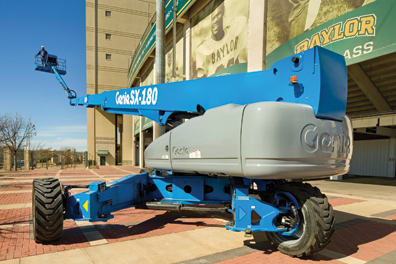Industry Outlook: Aerial Work Platforms
Safety, application specificity, productivity
drive new product development
By Mike Martin
|
|
Two key factors continue to drive development of aerial work platforms. The first, ongoing and with emphasis from manufacturers, rental centers and the International Powered Access Federation, is operator safety. Training programs are available for dealers, contractors and rental centers to use so that safety becomes a primary focus for all operators.
Second, is the continual fine-tuning of lift equipment to better fit the needs of your contractor customers. Offering the right aerial work platforms to best meet customers’ specific job site and project needs enhances their productivity, helping them avoid being over- or under-equipped.
For this Industry Outlook section we asked manufacturers:
- What trends are influencing aerial work platform design or other improvements or updates? Are there new or evolving application needs that impact this? What rental or end-user needs are involved that are driving the changes?
- How is your company addressing these trends with product development, recently introduced all-new products, or through changes/improvements to your current product line-up?
- Do you provide safety training as part of your customer/user services? If so, how do you make it available?
We also asked them to provide any other pertinent information they thought would have value to pro contractor rental businesses.
Here’s what they had to say:
 Karen Stash, Senior Director Marketing & Product Management
Karen Stash, Senior Director Marketing & Product Management
Terex AWP
There is an unmet demand for new types of larger equipment, such as our SX-180 telescopic boom lift. This height of boom allows an efficient way to work at heights previously reachable by other means. The industry hasn’t seen this before and customers are really responding to our innovation. We heard that they wanted to go higher, and we delivered.
We also recently introduced our Genie GTH-1544 telehandler which speaks to the trend toward larger telehandlers, not only at larger construction sites, but also for the burgeoning oil and gas industries, in mines and in ports.
The mandatory changeover to Tier 4 is also noteworthy. The implementation is staggered over the next several years and requires significant reengineering to fit the larger engines. These new engines do require significant resources but we are using it as an opportunity to make other improvements to each of the models that are affected.
Genie has addressed market trends and needs by recently introducing several innovations including the Genie SX-180 telescopic boom. It’s the largest of our aerial booms, and is suited for applications in the oil and gas industries, commercial construction, industrial construction and maintenance, and general maintenance. The machine is designed to be driven slowly at full height, and our X-chassis extends and retracts to provide both stability on the job and a narrow profile for transport. The machine requires no over-width or over-height permits allowing it to be easily transported on a truck. This same X-chassis design is used on our Genie ZX-135 articulating boom. This allows our big booms to share many design features providing parts and operating commonality.
Hybrids are a trend that will be a long-term play. As engines get more expensive, having good hybrid electric performance, with a smaller engine to charge the battery, makes sense.
At ARA we introduced the next evolution of the Genie 69-inch RT and DC scissor lift series, and the new Genie BE69 models, offering job site versatility. The new Genie GS-2669, GS-3369 and GS-4069 BE hybrid scissor lifts are “start to finish” machines. In the early stages of construction, the scissor keeps itself charged and can supply AC power when onsite power is not available. As the job site progresses it can switch from rough terrain environments, changing from a diesel to an electric machine which works in indoor slab environments. This type of versatility leads to higher utilization for rental companies.
SmartLink is a control system designed and built by Genie for the next generation of equipment. It provides end-users with intuitive and easy-to-use controls that are common across all units and makes operation more precise with multi-speed controls. The patented system allows the customer to diagnose problems by connecting a standard ethernet cable to an internet-ready computer. For customers, this solves the most difficult portion of troubleshooting a machine and helps makes Genie products stand out.
From a safety standpoint, the increasing demand for aerial work platforms on job sites has created an even greater need for well-trained, qualified operators. As new training requirements emerge from regulatory and standards bodies, contractors will need to provide increased training of employees on the equipment they’ll be using on the job site. That is why we introduced Genie Lift Pro last year.
The Genie Lift Pro training program consists of two comprehensive training segments: an online-based training course, which includes quizzes and a final exam; and hands-on training and familiarization, which takes place under the supervision of a qualified trainer or instructor at an authorized Genie Lift Pro training center. Completing the Genie Lift Pro training program could mean fewer accidents. By allowing operators to learn at their own pace, more information is retained and applied once those users get out on the job site.
The Genie Lift Pro training covers most brands, makes and models of aerial work platforms. This simple and informative path to aerial work platform operator qualification is available through a network of authorized training centers in North America. In fact, the hands-on portion of the training takes place at the dealership or rental house where the program was purchased. (For more information on how to participate in this training program, visit www.genielift.com.)
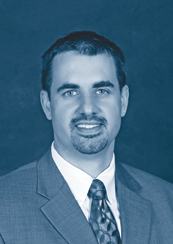 Jeff Ford, Global Product Director, Aerial Work Platforms
Jeff Ford, Global Product Director, Aerial Work Platforms
JLG Industries, Inc.
We are seeing two concurrent macro-trends that are shaping product development. The first trend is environmental sensitivity. The industry is starting to recognize that using machines that are more environmentally compatible is not just something they need to do to be politically correct, but it actually gives their customers a working advantage. Machines with low noise and lower emissions let crews work in locations where traditional diesel machines would not be allowed to operate. Another advantage is that crews may, in some locations, be allowed to start daily work earlier and run later because some of these next-next-generation machines can operate below noise-level regulations.
The second trend is the expanding of AWP to both higher and lower applications. We are seeing more demand for larger big booms used in the construction of wind, solar and other energy-generation installations. On the other end, we’re seeing more users who understand the safety and productivity benefits of AWPs in low-level applications, particularly indoors. Light construction and plant maintenance, for example, are moving from ladders to AWPs, which are more user-friendly.
We’re addressing these trends with our product development and introduction. For example, JLG recently introduced its H340AJ hybrid boom lift, which is a true hybrid that provides performance like a diesel. It can operate for up to seven hours on a single battery charge, indoors or out. Its 8.9-hp diesel engine is very low noise – less than 70 dB – so even when the engine is in use the machine can work in areas where environmental noise is a concern. And the diesel, because of its size, produces very low emissions. This is just one example of the many green innovations JLG is bringing to market.
We are also on top of the trend toward safe, low-level access. For example, our line of battery operated compact crawler booms feature non-marking treads and a weight displacement design that allows the machine to be used indoors, even on delicate and high-value flooring. One example would be historic buildings, where the flooring and infrastructure were not built to accommodate heavy loading. Our compact crawler booms can also go up and down stairs and fit through many standard-sized commercial doorways, so users can get to interior locations that in the past could only be accessed using extension ladders or scaffolding – for example in indoor atriums or multi-story halls, such as performance centers, universities or government buildings.
Our LiftPod personal portable lift is another innovation in low-level access that was created from user feedback. It allows maintenance workers to reach 14- to 20-feet to perform tasks in an enclosed platform with a lanyard anchor tethered to a safety harness. That means they can work with both hands free, have all their tools readily accessible, and they don’t need additional workers to steady their ladder or platform. And when it’s time to move, they can move the LiftPod by themselves, saving man-hours and labor costs.
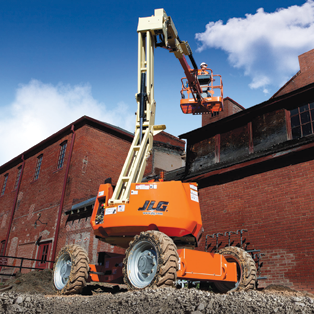 JLG’s training and education offering, called JLG University, is an award-winning program that covers three major areas: service training for equipment maintenance, operator training and “train the trainer” courses for those who teach others. Courses are available at the customer’s site, online, and at JLG’s facility in McConnellsburg, Pa.
JLG’s training and education offering, called JLG University, is an award-winning program that covers three major areas: service training for equipment maintenance, operator training and “train the trainer” courses for those who teach others. Courses are available at the customer’s site, online, and at JLG’s facility in McConnellsburg, Pa.
JLG University currently trains about 3,800 students per year using a combination of interactive computer-based tutorials, simulation, classroom and hands-on experience to develop students to the highest possible levels of competence.
JLG is just finishing an expansion of its McConnellsburg training facility that quadruples its size, to accommodate increased demand from JLG customers for more training. The site will also be home to the industry’s first Proving Grounds course, scheduled to open this summer. The course gives students a place to operate telehandlers, boom lifts and scissor lifts on a purpose-built course that recreates real work environments. Students will pick up, move and place loads while navigating obstacles and hazards, including slopes, grades and telephone poles with simulated power lines. They will be challenged to position booms or scissors to safely retrieve markers from height.
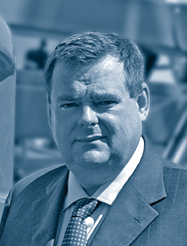
Malcolm Early, Vice-President of Marketing
Skyjack
We know the rental industry is looking for high life-cycle value through low cost of ownership, ease of service and maintenance while retaining high residual values. At Skyjack, we design our products specifically for the equipment rental industry and that focus allows us to offer a wide range of scissor lifts that provide:
- Competitive acquisition costs
- Consistent high residual values that minimizes disposal costs
- Reliability and robustness so equipment uptime is maximized
- Common components across model groups, which minimizes service parts needed and lowers the cost of ownership
- Customized financial solutions tailored to users’ unique needs
- Reconditioning services that extend life cycle and increase return on investment.
Our focus on product development is tied to knowing that rented equipment pays for itself only when it is working, which is why designing equipment capable of surviving in the rental industry is fundamental to our philosophy.
In 2013, the biggest development in Skyjack booms was the launch of the SJ63 AJ. It has an innovative, open-center knuckle riser design that provides an extensive working envelope (even offering below ground-level reach) while maintaining a low overall stowed height for transportation. We were excited to launch the SJ 6832 RTE at CONEXPO 2014. The approach was to minimize product specification changes and focus on the “power delivery” using battery and electric motors. This approach is attractive as a philosophy for Skyjack’s other internal combustion scissors or booms, but no concrete plans have been made yet.
Skyjack’s reliability comes from steel construction – strong, durable and easy to repair. Our products offer:
- Excellent accessibility to all major components so that maintenance and service routines have reduced turnaround times;
- Hard-wired, relay-based control systems, which are easy to troubleshoot and repair. Using commonly available components means equipment uptime is maximized;
- No complicated and expensive computers or can-bus systems, which require a PC to diagnose;
- Standard color-coded and numbered wiring across the range reduces troubleshooting time and gets the equipment back on rent faster;
- Common components across model groups are used wherever possible – 80% of recommended service parts across the range are common – reducing stock holding needs;
- The use of “off the shelf” components as opposed to custom designs, means that replacing or repairing components is easy and cost effective;
- Replaceable modular platform railings and repairable fiber glass cowlings reduce costs.
We also have a wide range of accessory products. These help expand an aerial work platform’s adaptability so that rental companies can offer a truly flexible rental choice. Some of the accessories include glazier kits. Designed for use on Telescopic Boom Lifts and Articulated Boom Lifts, the Skyjack Glazier kit provides a glass and panel tray that holds outside the platform. It reduces operator fatigue while protecting panels from damage and leaves the platform free for tools and personnel.
If your contractor customers are holding and lifting sheet materials, our Board Carrier will help improve productivity. It’s easily installed, it’s safe and simple, making lifting material easier, quicker and less strenuous. Plus it leaves the platform free for tools, other light material and people. Skyjack’s pipe rack and stud racks are meant for maximizing platform work space without sacrificing productivity. The pipe rack is an ideal aid for plumbers, electricians and maintenance workers, who want to organize platform materials without limiting machine movement within tight spaces.Tool carriers help contractors keep tools within arm reach. We believe it is ideal for maintenance work across a wide range of facilities – from airports to factories to entertainment facilities and more.
We offer the industry’s first standard two-year full “bumper to bumper” warranty on aerial work platforms together with a five-year warranty on structural components for no extra charge, which adds to our product life-cycle value. Skyjack’s Safety First program
offers IPAF/AWPT-approved training courses, instructor and operator training kits, a web-based resource center and Aerial Work Platform and Telehandler training. Skyjack offers two training programs:
- Operator Training – Certified to be in compliance with the ISO Standard 18878 Mobile elevating work platforms. Leading to receiving a Powered Access License (PAL).
- Registered Instructor Training – Designed to ensure the delivery of both the AWPT & Skyjack programs.
Skyjack and AWPT Training Programs are generic and applicable to all brands of machines.
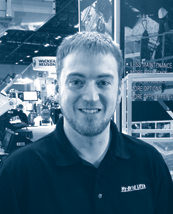 Justin Kissinger, Marketing Manager
Justin Kissinger, Marketing Manager
Custom Equipment, Inc.
Safety is always a concern on any job site, but especially in the rental industry where operators with little experience could be using the equipment. Safety on aerial work platforms is constantly evolving. Many accidents occur when individuals fall from elevated areas and that risk is increased when they are working on ladders or scaffolding. More companies are relying on alternatives to ladders by working with low-level lifts such as the Hy-Brid push-around units. These units eliminate many of the safety issues related to ladders and scaffolding. They provide a quick and easy system for maneuvering and also offer greater capacity and efficiency. The Hy-Brid HB-P827 push-around lift offers a working height of 14 feet and a capacity of 500 pounds, which allows users to effectively perform a variety of tasks with all of the materials they may need with them on the lift. The working heights of Hy-Brid’s push-around units range from 11 to 16 feet, and they are an ideal solution for nearly any application where ladders or scaffolding would be used.
Beyond the safety associated with replacing ladders and scaffolding, many lift manufacturers also are building additional safety features into their units. These features range from lower entry heights to full access swing gates to tilt sensors.
We work to address these safety and productivity trends by designing our lifts with a number of performance features and key safety features. For example, our lifts have step heights as low as 18 inches, which reduces the possibility of falls and nearly eliminates the repetitive movement injuries associated with the industry standard 42-inch steps.
Hy-Brid lifts feature full-access swing gates, as well. These gates make it easier and safer to load and unload tools and supplies without crawling under or over a bar, which users may need to do with lifts made by other manufacturers. In addition, a tilt sensor alerts the operator if the lift is positioned at an unsafe incline to prevent tipping during lifting.
We implemented these safety features after extensive testing and feedback from our customers. But beyond these safety features, the design concept for Hy-Brid is inherently focused on safety. Our lifts offer platform heights of up to 14 feet, which is more than adequate to accomplish more than 90 percent of all necessary functions. And, because the lifts feature a lower platform height, the risk of crushing an operator between the lift and the ceiling is nearly eliminated.
We focus on providing the best lifts for the job in all situations. At Custom Equipment, we design our products to improve not only safety, but also ease of overall operation. We do that by using lightweight materials for low floor-load requirements. Our compact designs make maneuverability easy, even in confined spaces, and our high platform capacities increase efficiency.
We have continued this with many of our most recent products, including our 8-foot HB-830 and 12-foot HB-1230 lifts, which offer zero-turn radiuses for hassle-free maneuverability around corners. They replace larger scissor and vertical mast lifts to give users more working space and greater platform capacities for increased efficiency.
We also now offer push-around scissor lifts with 5-, 8- and 10-foot platform heights. Hy-Brid push-around lifts are a cost-effective alternative to larger drivable lifts, and because they can be maneuvered into more confined areas where ladders would typically be used, they virtually eliminate the risk of falls.
Our lifts are very straightforward and easy to use, but for users that want additional training, the International Powered Access Federation (IPAF) has many in-depth and hands-on training courses. Custom Equipment has been a member of IPAF for many years and is confident in the association’s ability to provide relevant and informative training to people in the industry.
Hy-Brid lifts are used in a multitude of industries, including construction, HVAC, electrical and plumbing. We have discovered that 90 percent of all jobs done in these industries require a working height of 19 feet or less. We also asked contractors in many of those industries to tell us what working heights they need to get their projects done. Nearly 62 percent said they were using scissor lifts with platform heights of 20 feet or greater, but less than 9 percent were actually working at those heights. When contractors use a taller lift than they need, they put themselves at risk for crushing accidents, and they sacrifice maneuverability and overall ease of use.
Originally published in the May/June 2014 issue of Pro Contractor Rentals. Copyright 2014 Direct Business Media.



